The Kriya Yoga of Babaji (Excerpt from book Wings to Freedom)
By Yogiraj Satgurunath Siddhanath
Pranayama is derived from its Sanskrit roots, prana (life) and ayama (control). Pranayama is therefore life-force control and not breath control. Kriya yoga is a dynamic process of pranayama through the spinal cord which transforms the latent impressions stored in the subconscious mind into positive life force energy growth. When the breath moves in the spinal cord during the Kriya breath, it contacts certain astral plexuses known as the pranic lotuses- the chakras. When the breath passes through the chakras it nullifies negative Karmas along with bodily disease, mental disease of stress and tension and emotional suffering. Holding your astral chakras is the DNA, the personal genome of each individual that is the secret of his being. The DNA has four nitrogen nubs which records all actions past, present and future of the individual. Nobody can escape from this memory of the gene.
The kriya breath moved in the spinal cord with intent and concentration generates the power to rub out this record in the DNA, thereby nullifying it. By this frictional effect, the three Karmas- sanchit, prarabdha and bhavishya – (i.e. past, present and future respectively) stored in the chakras and the limbic system of the brain and analogous to the DNA, are gradually wiped out. This depends on the dedication and steadfastness of the practice of Kriya yoga.
There are two main life-currents in the body. One is that of prana which flows from the coccyx to the point between the eyebrows. The nature of this life current is soothing. It introverts the devotee’s attention during sleep and the wakeful state, and in meditation unites the soul with the spirit in the third ventricle of the brain called the shiva netra or third eye.
The other main current is that of apana which flows from the third eye to the coccyx. This downward flowing extroverted current distributes itself through the coccyx center to the motor-sensory nerves. It keeps man’s consciousness delusively tied to the body. The apana current is restless and engrosses man in sensory experiences.
The science of Kriya Yoga pranayam offers the inhaled pranic breath into the exhaled apanic breath and vice versa. By this process the yogi neutralizes the two life currents of prana and apana resulting in the arrest of decay and growth in the body. This is done by rejuvenating the blood and body cells with life energy (prana) that has been distilled from the breath and moved into the spine and the brain. The Kriya yogi arrests all bodily decay, thereby quieting the breath and heart.
Kriya Yoga pranayama arrests bodily decay connected with apana, manifesting in the exhaling breath, by fresh inhalations of life-force (prana) distilled from the inhaling breath. This prana enables the devotee to do away with the illusion of decay and mutation.The body of the Kriya yogi is recharged with extra energy distilled from the breath and energized by the tremendous dynamo of energy generated in the spine. The decay of body tissues decreases. This ultimately makes unnecessary the blood cleansing functions of the heart. The heart pump becomes quiet owing to the non-pumping of venous blood and exhalation and inhalation of breath are evened out. The life energy unites in the currents in the spine. The light of pure prana scintillates from the six chakras to all the bodily cells keeping them in a spiritually magnetized condition.
Kriya Yoga is referred to obliquely in Yoga treatises as kevali pranayama or kevali kumbhaka (Hatha Yoga Pradipika II-73). This is the true pranayama that has transcended the necessity for inhalation (puraka) and exhalation (rechaka); breath is transmuted into inner life-force currents under the complete control of the mind. When the breath stops effortlessly without either rechaka or puraka – that is kevali kumbaka (Hatha Yoga Pradipika II-73).
Of the various stages of pranayama (such as breathlessness), kevali is extolled by adept yogis as the best or highest (remember that Kriya Yoga is not breath control but life-force control). When one gets to the advanced state of Shiva Shakti Kriya, the breath ceases. Duly the cool ascending pranic current and warm descending apanic current are felt flowing in the sushumna nadi (spinal cord). This is an avasta (state) of kevali kumbaka.
Kriya is a process of converting breath into life-force and realizing the body as light. By the perfect performance of Kriya 1,728 times in one posture (that is, at one time) and by practicing a total of 20,736 kriyas a devotee can reach a state of samadhi (God contact). But Kriya cannot be practiced so many times by a beginner. When the body and mind of the yogi are prepared to accommodate the high voltage of so much Kriya Yoga, his Guru will advise him that he is ready for the experience of samadhi. If the kriyas are broken into several sittings, there is no harm. It will just take longer.
“Greater is the yogi than body-disciplining ascetics, greater even than the followers of wisdom’s path. Greater than the path of action. Be thou Arjuna a yogi!” (Bhagavad Gita, chapter 6 verse 46). The Gita advises us to practice pranayama (life-force control).
All copyright Yogiraj Satgurunath Siddhanath
More info on Kundalini Kriya Yoga on www.siddhanath.org

